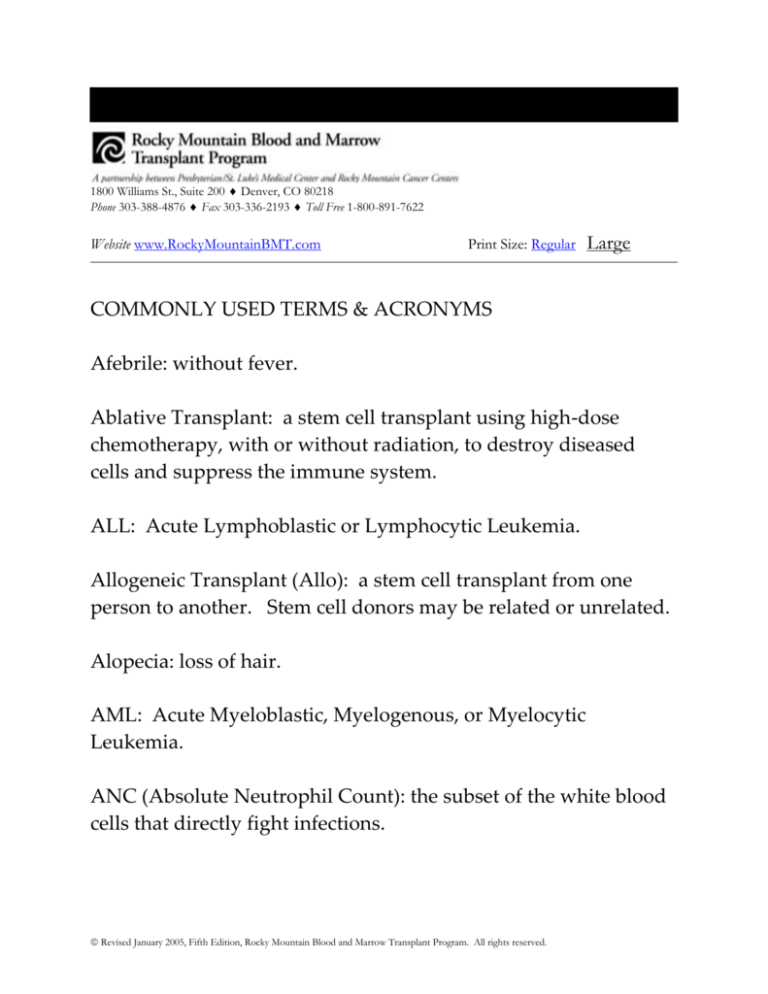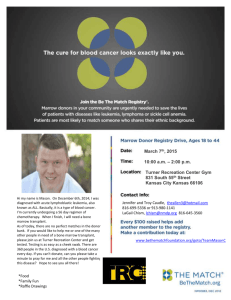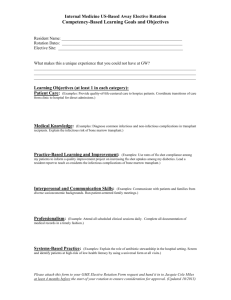
1800 Williams St., Suite 200 Denver, CO 80218
Phone 303-388-4876 Fax 303-336-2193 Toll Free 1-800-891-7622
Website www.RockyMountainBMT.com
Print Size: Regular
Large
COMMONLY USED TERMS & ACRONYMS
Afebrile: without fever.
Ablative Transplant: a stem cell transplant using high-dose
chemotherapy, with or without radiation, to destroy diseased
cells and suppress the immune system.
ALL: Acute Lymphoblastic or Lymphocytic Leukemia.
Allogeneic Transplant (Allo): a stem cell transplant from one
person to another. Stem cell donors may be related or unrelated.
Alopecia: loss of hair.
AML: Acute Myeloblastic, Myelogenous, or Myelocytic
Leukemia.
ANC (Absolute Neutrophil Count): the subset of the white blood
cells that directly fight infections.
Revised January 2005, Fifth Edition, Rocky Mountain Blood and Marrow Transplant Program. All rights reserved.
Page 2 of 13
Anemia: a lower than normal number of red blood cells
circulating in the blood.
Antiemetic: a group of drugs used to control nausea and
vomiting.
Antimicrobial: medications given for prevention and treatment
of bacterial, viral, and fungal infections.
Apheresis: a procedure that circulates blood through a machine to
remove cell components, for example, stem cells, platelets.
Arterial Blood Gas (ABG): a test performed on blood drawn from
an artery that identifies the amount of oxygen and carbon dioxide
in the blood.
Ascites: accumulation of fluid in the abdominal cavity, often due
to liver damage.
Aspirate: to remove by suction.
Autologous Transplant (Auto): a stem cell transplant where a
patient's cells are collected, frozen, then returned to the patient.
Blast Crisis: an advanced stage of chronic myelogenous
leukemia, similar to acute leukemia, where there are a large
number of immature "blast" cells circulating in the blood stream.
Revised January 2005, Fifth Edition, Rocky Mountain Blood and Marrow Transplant Program. All rights reserved.
Page 3 of 13
Biopsy: the removal of tissue for the purpose of making a
diagnosis.
Blood Typing & Cross-Matching: red blood cells contain factors
which are not the same in all people. Before giving a transfusion,
blood samples from donor and patient are typed (i.e., A, AB, B, 0)
to see if they match. Once typed, the samples are cross-matched
to double-check that they are compatible.
Bone Marrow (BM): the soft, sponge-like material in the center of
bones that produces blood cells.
Bone Marrow Transplant (BMT): a transplant that uses stem cells
collected from bone marrow.
Candida: a type of yeast, common to the mucosa, that can cause
infection in immune-suppressed patients.
CAT or CT Scan (Computed Tomography Scan): a 3D X-Ray.
CD34+ : is a visually distinguishing feature of a stem cell not
found in other cells. This unique feature helps us count the
number of stem cells in your blood stream and aids in collecting
stem cells.
Central Venous Catheter (CVC): a tube surgically placed in a
large vein in the upper chest or neck (e.g., Opti Flow, Hickman,
Revised January 2005, Fifth Edition, Rocky Mountain Blood and Marrow Transplant Program. All rights reserved.
Page 4 of 13
Quinton, Groshong). Fluids, such as blood and/or chemotherapy,
may be infused through this catheter and blood samples can be
withdrawn from it.
Chemotherapy: drugs used to treat diseases by destroying
abnormal cells or slowing their growth.
Chest X-Ray (CXR): a radiologic study of the chest that includes
the heart, lungs, and ribs.
Clinical Trial: the study of the effects of drugs, equipment, or
procedures according to a formal research plan for a particular
disease or group of diseases.
CLL: Chronic Lymphocytic Leukemia.
CML: Chronic Myelogenous Leukemia.
Conditioning Regimen: chemotherapy, radiation and/or
immunosuppressive agents given in preparation for stem cell
transplant.
Cryopreservation: to preserve by freezing. Autologous patients
will have their stem cells cryopreserved after collection then
thawed prior to transplant.
Culture: a sample of a body fluid (e.g., blood, urine) or tissue
taken to detect the presence of an infection and to identify the
organism responsible.
Revised January 2005, Fifth Edition, Rocky Mountain Blood and Marrow Transplant Program. All rights reserved.
Page 5 of 13
Cytomegalovirus (CMV): a virus that is detectable in the majority
of adults. The virus often reactivates when a patient is
immunosuppressed. When active, the virus can cause an
infection in the lungs (pneumonia), intestine (enteritis), or blood
(viremia).
Cytoxan (CTX or CY): the brand name of a chemotherapy drug
(cyclophosphamide) used to destroy cancer cells or to mobilize
stem cells.
Day 0: the day a patient receives his/her stem cell transplant. The
days before transplant are called “minus” days (e.g., Day – 7
means there are seven days until transplant) and the days
following transplant are called “plus” days (e.g., Day +2 is two
days after transplant).
Differential (diff): the breakdown of the white blood cell
components, such as lymphocytes, neutrophils, eosinophils and
monocytes.
DLCO: a test of the lungs that determines the amount of oxygen
taken into the body and carbon dioxide expelled.
Revised January 2005, Fifth Edition, Rocky Mountain Blood and Marrow Transplant Program. All rights reserved.
Page 6 of 13
Donor Cell Infusion (DCI): an additional infusion of donor cells
given to Allogeneic patients following their transplant to induce a
Graft versus Malignancy effect.
Electrolytes (lytes): mineral salts that are normally found in the
blood stream. The correct level of each electrolyte is important for
the overall functioning of the body. Examples are: sodium,
potassium, and magnesium.
Emesis: vomiting.
Engraftment: the growth of new bone marrow cells following
transplant. White blood cell engraftment is determined by the
ANC: three consecutive ANC’s greater than 500 define
engraftment.
Febrile: fever.
Foley Catheter: a tube placed in the bladder to drain urine.
GI tract: gastrointestinal (digestive) tract.
Graft Versus Host Disease (GVHD): a condition where
transplanted cells from the donor attack the cells of the host's
body. In the first 100 days, the tissues most likely to be attacked
are the skin, GI tract, and the liver.
Graft Versus Malignancy or Leukemia: a phenomenon where
transplanted cells of the donor attack the patient's malignant cells.
Revised January 2005, Fifth Edition, Rocky Mountain Blood and Marrow Transplant Program. All rights reserved.
Page 7 of 13
Growth Factors: a protein that stimulates the production and
growth of blood cells, e.g., Neupogen (G-CSF), Aranesp or
Neulasta.
Harvest: the process of collecting stem cells from patients’ or
donors’ peripheral blood, bone marrow or cord blood.
Hodgkin Lymphoma: HL
Hematocrit (crit, Hct): the percentage of red blood cells (normal
ranges for women are 37-47% and men are 42-54%).
Hematology: a medical specialty that focuses on diseases of the
blood and blood forming tissues.
Hematuria: blood in the urine.
Hemoglobin (Hgb): iron-containing protein found in red blood
cells that carries oxygen (normal ranges for hemoglobin are
between 12-18 Gm/dl).
Hemmorrhagic Cystitis: bleeding from the lining of the bladder
caused by irritants, such as cytoxan and ifosphamide or viruses
such as BK, CMV or adeno.
Herpes Simplex Virus (HSV): a virus that causes infections such
as cold sores. Over 90% of adults have been exposed to this virus
by age 20.
Revised January 2005, Fifth Edition, Rocky Mountain Blood and Marrow Transplant Program. All rights reserved.
Page 8 of 13
HLA Typing (Human Leukocyte Antigen Typing): molecular
testing of blood DNA used to find donors for allogeneic
transplant. This test is run primarily from blood samples.
Irradiation: treatment with x-rays or other radioactive
substances. See TBI.
Performance Score: a method of rating a patient's level of activity
or performance status. This score gives an overall estimate of
physical health. Performance status is an important factor in
determining eligibility for transplant.
Liver Function Tests (LFTs): lab tests performed on a blood
specimen that gives information about liver function, for
example, bilirubin and transaminases.
Low Microbial Diet (LMD): a diet designed to eliminate foods
which often contain large numbers of microorganisms/
bacteria.
MDS: Myelodysplastic Syndrome.
Metastatic: spread of cancer from an organ or tissue of origin to
another part of the body.
MM: Multiple Myeloma.
Revised January 2005, Fifth Edition, Rocky Mountain Blood and Marrow Transplant Program. All rights reserved.
Page 9 of 13
Mobilization (priming): the process used to move stem cells from
the marrow into the circulating blood. Growth factors, with or
without chemotherapy, are used in this process.
MRI (Magnetic Resonance Imaging): a type of scan that takes
pictures of the body using magnetic fields and radio waves.
Mucositis: inflammation and ulceration of the mucous
membranes. Transplant patients can experience mucositis in the
mouth, throat and esophagus.
MUD (Matched Unrelated Donor Transplant): a transplant in
which the donor and recipient are unrelated but have matching
HLA types.
Neutropenia: a low number or lack of the neutrophils needed to
fight infection.
NHL: Non-Hodgkin Lymphoma.
Non-myeloablative transplant (reduced intensity; miniallogeneic): an Allogeneic stem cell transplant that uses lower
doses of chemotherapy and/or radiation. The goal of the therapy
is to make room for the donor cells.
Oncology: the study of cancer.
Packed Red Blood Cells (PRBC): a method of preparing red blood
cells for transfusion.
Revised January 2005, Fifth Edition, Rocky Mountain Blood and Marrow Transplant Program. All rights reserved.
13
Page 10 of
Pancytopenia: a condition where a patient has fewer white blood
cells, red blood cells and platelets than normal.
Patient Controlled Analgesic (PCA): a method of delivering
intravenous pain medications with a pump that allows the patient
to self-administer the medication when needed.
PET Scan (Positron Emission Tomography): a scan that takes
pictures of the body and shows whether there are unusually high
amounts of nutrients being processed.
Perineum (Perineal Area): the area between the rectum and the
external genitalia. This area is vulnerable to infection during
periods of neutropenia.
Peripheral Blood: blood cells found in blood vessels (as opposed
to blood cells found in the bone marrow).
Perirectal: the area around the rectum.
PICC: a peripherally inserted central catheter that is inserted into
a large vein in the arm. This catheter can be placed at the bedside
by a trained nurse or in radiology by a physician.
Platelet (PLT): a type of blood cell that helps the blood to clot. The
normal range for platelets is between 150,000 -500,000/mm3. An
increased risk of serious bleeding occurs when platelets drop
below 50,000/mm3.
Revised January 2005, Fifth Edition, Rocky Mountain Blood and Marrow Transplant Program. All rights reserved.
13
Page 11 of
Pluripotent Stem Cell: a primitive cell from which all other blood
cells originate; also called a stem cell.
Prophylactic: preventive.
Protocol: a standardized plan of treatment and evaluation
designed to address a research question.
P/SL: Presbyterian/St. Luke’s Medical Center.
Psychosocial: the psychological and social aspects of a person, for
example, marital status, age, education, support network, and
coping skills.
Pulmonary Function Tests (PFTs): a test used to evaluate the
capacity of the lungs by measuring the flow of air into and out of
the lungs.
Randomization: random assignment of patients to different types
of treatment specified in a clinical trial.
Red Blood Cell (RBC): a type of blood cell containing hemoglobin
that transports oxygen throughout the body.
Relapse: recurrence of disease.
Revised January 2005, Fifth Edition, Rocky Mountain Blood and Marrow Transplant Program. All rights reserved.
13
Page 12 of
Respiratory Syncytial Virus (RSV): a common virus that causes a
cold in healthy adults. However, it can lead to serious
pneumonia in patients with a weakened immune system.
Restaging: a system of re-evaluating your disease characteristics
and spread. Also, assessing your baseline organ functionality to
determine your body’s ability to tolerate the rigors of high-dose
chemotherapy treatments associated with a transplant. Restaging
may involve x-rays, scans, blood tests, biopsies, pulmonary
function tests, heart scans, EKG, and urine tests.
RMCC: Rocky Mountain Cancer Centers.
SAA: Severe Aplastic Anemia.
Solid Tumor: a cancer that originates in an organ or tissue other
than the bone marrow or lymph system (e.g., Testicular or Breast
cancer).
Staging: a system of quantifying disease characteristics and
spread. Staging may involve x-rays, scans, blood tests, and
biopsies.
Stem Cell: a cell from which all other blood cells originate; also
called a pluripotent stem cell.
Stomatitis: inflammation and ulceration of the lining of the
mouth. Stomatitis is one type of mucositis.
Revised January 2005, Fifth Edition, Rocky Mountain Blood and Marrow Transplant Program. All rights reserved.
13
Page 13 of
Syngeneic Transplant: a stem cell transplant from one HLA
identical twin to the other.
Thrombocytopenia: a lower than normal number of platelets
defined as less than or equal to 50,000/mm3.
Total Body Irradiation (TBI): a type of irradiation delivered to the
entire body.
Total Parental Nutrition (TPN): intravenous (IV) fluids infused
through a central venous catheter to provide nutrients, vitamins,
and minerals that normally would be received from food. Also
called hyperalimentation (HA).
Treatment Guidelines: a nationally recognized standard of care
for the treatment of a specific disease.
Unrelated Donor (URD Transplant): an Allogeneic transplant
where the donor and recipient are unrelated.
URI: Upper Respiratory Infection.
White Blood Cell (WBC): the cells that help your body to fight
infections. Normal ranges for white blood cells are between 4,50011,000/mm3. Different types of white blood cells include
neutrophils, lymphocytes, monocytes, and eosinophils.
Xerostomia: dry mouth caused by decreased or absent saliva
production, which is a side effect of TBI and chemotherapy.
Revised January 2005, Fifth Edition, Rocky Mountain Blood and Marrow Transplant Program. All rights reserved.




